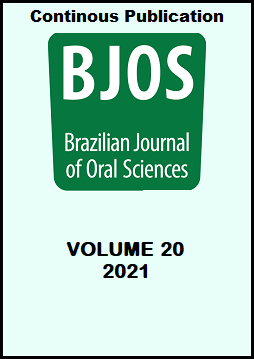Abstract
Aim: to develop a model for regenerative endodontics using newly-weaned Wistar rats immature molars with pulp necrosis to histologically describe the evolution of apical tissues following treatment with a bi-antibiotic paste, induced bloodclot formation and MTA. Methods: Ten 25-day-old female Wistar rats were divided into an initial control group (Ci) and two experimental groups in which pulp necrosis was experimentally induced on the left mandibular first molar by exposing the pulp chamber and leaving it open to the oral environment. One of the experimental groups was left untreated (E1) while the other was submitted to a protocol of regenerative endodontics 10 days thereafter (E2). Fifteen days after placement of a bi-antibiotic paste, bleeding was induced into the root canal space and MTA was placed upon. Animals were euthanized 30 days later. Right mandibular first molars served as an 80-day-old final control group (Cf). Each hemimandible was histologically processed to analyse parameters associated with root development. Statistical analysis was carried by means of ANOVA; p values below 0.05 were considered statistically significant. Results: baseline (i.e. 25-days old) mean root length and apical diameter of the distal root canal were 1.84±0.25 and 0.38±0.02mm respectively. Following the regenerative endodontic protocol, cells lining the walls of the root canal and significant increase to both length (2.37±0.22mm) and diameter (0.32±0.03 mm) were observed. Conclusions: newly-weaned Wistar rats serve as a suitable model to evaluate regenerative endodontic protocols. However, further research is needed in order to disclose the nature of the cells and/or cell mediators involved.
References
- American Association of Endodontists. Glossary of endodontic terms. 10th ed. Chicago: AAE; 2019.
- Ostby BN. The role of the blood clot in endodontic therapy. An experimental histologic study. Acta Odontol Scand. 1961 Dec;19:324-53.
- Hargreaves KM, Diogenes A, Teixeira FB. Treatment options: biological basis of regenerative endodontic procedures. J Endod. 2013 Mar;39(3 Suppl):S30-43. doi: 10.1016/j.joen.2012.11.025.
- Diogenes A, Ruparel NB, Shiloah Y, Hargreaves KM. Regenerative endodontics: a way forward. J Am Dent Assoc. 2016 May;147(5):372-80. doi: 10.1016/j.adaj.2016.01.009.
- Huang GT, Sonoyama W, Liu Y, Liu H, Wang S, Shi S. The hidden treasure in apical papilla: the potential role in pulp/dentin regeneration and bioroot engineering. J Endod. 2008 Jun;34(6):645-51. doi: 10.1016/j.joen.2008.03.001.
- Huang GT. Apexification: the beginning of its end. Int Endod J. 2009 Oct;42(10):855-66. doi: 10.1111/j.1365-2591.2009.01577.x.
- Nosrat A, Kolahdouzan A, Hosseini F, Mehrizi EA, Verma P, Torabinejad M. Histologic outcomes of uninfected human immature teeth treated with regenerative endodontics: 2 case reports. J Endod. 2015 Oct;41(10):1725-9. doi: 10.1016/j.joen.2015.05.004.
- Huang GT, Garcia-Godoy F. Missing concepts in de novo pulp regeneration. J Dent Res. 2014 Aug;93(8):717-24. doi: 10.1177/0022034514537829.
- Alexander A, Torabinejad M, Vahdati SA, Nosrat A, Verma P, Grandhi A, et al. Regenerative endodontic treatment in immature noninfected ferret teeth using blood clot or synoss putty as scaffolds. J Endod. 2020 Feb;46(2):209-15. doi: 10.1016/j.joen.2019.10.029.
- Pulyodan MK, Paramel Mohan S, Valsan D, Divakar N, Moyin S, Thayyil S. Regenerative endodontics: a paradigm shift in clinical endodontics. J Pharm Bioallied Sci. 2020 Aug;12(Suppl 1):S20-6. doi: 10.4103/jpbs.JPBS_112_20.
- Stambolsky C, Rodríguez-Benítez S, Gutiérrez-Pérez JL, Torres-Lagares D, Martín-González J, Segura-Egea JJ. Histologic characterization of regenerated tissues after pulp revascularization of immature dog teeth with apical periodontitis using tri-antibiotic paste and platelet-rich plasma. Arch Oral Biol. 2016 Nov;71:122-8. doi: 10.1016/j.archoralbio.2016.07.007.
- Torabinejad M, Corr R, Buhrley M, Wright K, Shabahang S. An animal model to study regenerative endodontics. J Endod. 2011 Feb;37(2):197-202. doi: 10.1016/j.joen.2010.10.011.
- Altaii M, Cathro P, Broberg M, Richards L. Endodontic regeneration and tooth revitalization in immature infected sheep teeth. Int Endod J. 2017 May;50(5):480-91. doi: 10.1111/iej.12645.
- Oyhanart SR, Canzobre MC. Methodological considerations for a model of endodontic treatment in Wistar rats. Acta Odontol Latinoam. 2020 Dec;33(3):153-64.
- Thibodeau B, Trope M. Pulp revascularization of a necrotic infected immature permanent tooth: case report and review of the literature. Pediatr Dent. 2007 Jan-Feb;29(1):47-50.
- Hameed MH, Gul M, Ghafoor R, Badar SB. Management of immature necrotic permanent teeth with regenerative endodontic procedures - a review of literature. J Pak Med Assoc. 2019 Oct;69(10):1514-20.
- Scarparo RK, Dondoni L, Böttcher DE, Grecca FS, Rockenbach MI, Batista EL Jr. Response to intracanal medication in immature teeth with pulp necrosis: an experimental model in rat molars. J Endod. 2011 Aug;37(8):1069-73. doi: 10.1016/j.joen.2011.05.014.
- Yoneda N, Noiri Y, Matsui S, Kuremoto K, Maezono H, Ishimoto T, et al. Development of a root canal treatment model in the rat. Sci Rep. 2017 Jun;7(1):3315. doi: 10.1038/s41598-017-03628-6.
- Kaushik SN, Kim B, Walma AM, Choi SC, Wu H, Mao JJ, et al. Biomimetic microenvironments for regenerative endodontics. Biomater Res. 2016 Jun;20:14. doi: 10.1186/s40824-016-0061-7.

This work is licensed under a Creative Commons Attribution 4.0 International License.
Copyright (c) 2021 Brazilian Journal of Oral Sciences


